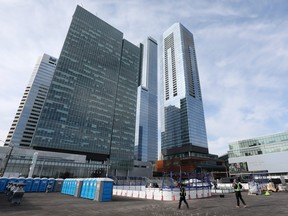The fight escalated with the boyfriend joining in, with at least one person stabbed, as a number of witnesses called for help from police

Article content
An Edmonton city police officer who opened fire on a man during a fight and stabbing at an Ice District Oilers playoff watch party last April has been cleared of any wrongdoing, says the province’s police watchdog.
The Alberta Serious Incident Response Team (ASIRT) was directed to investigate the non-fatal police shooting April 29, 2023, that occurred that evening during the investigation of a fight/disturbance near Ice District.
Advertisement 2
Article content
Article content
The Edmonton Oilers were in an NHL playoff game, with thousands in attendance for the watch party event organized in the downtown Ice District of Edmonton. Given the scope of the event and the number of people in attendance, extra city police officers had been called in, including the witness officer and the subject officer who were partnered together that evening, said a news release this week from ASIRT.
Both officers wore their police uniforms and yellow high visibility vests.
The man whom the officer would eventually fire on was attending the party with his girlfriend and prior to arriving had consumed about 13 ounces of vodka; the couple had also consumed some cocaine, said the report from ASIRT. The pair consumed more alcohol at the event.
The couple were walking on 101 Street, crossing the intersection at 103A Avenue, when words were exchanged around 9:15 p.m. with another group of adults, with a dispute arising between the girlfriend and the group. The fight escalated with the boyfriend joining in, with at least one person stabbed, as a number of witnesses called for help from police. The boyfriend has since been charged in relation to the fight.
Article content
Advertisement 3
Article content
The officer and his partner were standing on the west side of 101 Street when someone in the crowd said there was a fight had broken out across the street. The pair responded to the scene with someone yelling, ‘he has a knife,’ before one of the officers saw the knife being held blade down over a person’s head, said ASIRT.
Both officers commanded, at least twice, the suspect drop the knife before the man moved away with the weapon still in his hand. The officer who opened fire believed the suspect was moving towards he and his partner, a detail confirmed by an adult male witness who was in a vehicle with his wife and child at the time, ASIRT said.
The witness saw both officers draw their weapons and point them at the suspect before the suspect moved towards the officers with knife in hand. After the commands to drop the knife went unheeded, the officer in question discharged his service pistol twice.
The suspect fell to the ground, having been struck in the abdomen and left arm by the rounds.
The man was handcuffed and no other force was applied to him. Other police officers and Emergency Medical Services (EMS) personnel arrived soon after and the man, along with two participants in the fight, were taken to hospital.
Advertisement 4
Article content
One participant was treated and left the hospital. Another participant in the fight, as well as the man hit by bullets, both required surgery and both spent several days in hospital.
The ASIRT report concludes that the officer who fired the weapon “was lawfully placed and acting in the execution of his duties.”
Under s. 25 of the Criminal Code, police officers are permitted to use as much force as is necessary for the execution of their duties.
“Where this force is intended or is likely to cause death or grievous bodily harm, the officer must believe on reasonable grounds that the force is necessary for the self-preservation of the officer or preservation of anyone under that officer’s protection,” said ASIRT.
“With the benefit of hindsight, time for detached reflection and knowledge of the ultimate outcome, it is easy to speculate about how things could have been done differently. That is not the standard, however, against which an officer’s conduct is measured. The question is, applying principles of proportionality, necessity, and reasonableness, whether the force used falls into a range of possible reasonable responses.
“The force used was proportionate, necessary and reasonable in all the circumstances.”
Recommended from Editorial
Article content





